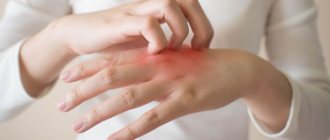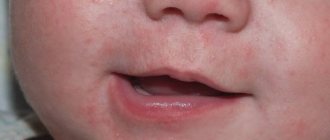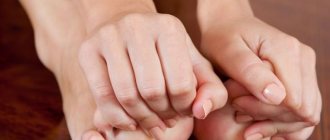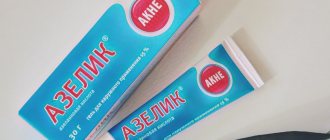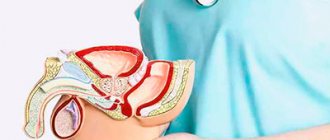Why do pimples appear and itch on the body?58
If small pimples all over your body itch, this may be a manifestation of one of the following dermatological diseases:
- Atopic dermatitis. It is a multifactorial inflammatory skin disease characterized by itching. The clinical picture of the disease may differ, including manifesting itself in the form of papules and vesicles.
- Bullous pemphigoid. The disease, as a rule, begins with the appearance of an erythematous, urticaria-like rash, papules, which are accompanied by itching.
- Vasculitis. The eczematoid type is characterized by the appearance of hemosiderosis, petechiae, eczematization (swelling, redness, papulovesicles, crusts), and the affected area is itchy.
- Dystrophic epidermolysis bullosa. The disease manifests itself from birth or from an early age. It is characterized by the formation of bubbles. In adults, the disease manifests itself in the form of plaques, lichenoid papules on the legs, and onychodystrophy. Severe itching provokes the appearance of milia and excoriations.
- Contact dermatitis. In addition to swelling, vesicles, and bullous rash, itching is also evident, sometimes the lesions hurt, and a burning sensation occurs.
- Hives. It may appear as small pimples on the body, they itch, and less often there is a burning sensation.
- Scabies is a parasitic dermatological disease
Causes of itchy pimples
These types of itchy pimples can occur for various reasons and are most often accompanied by different symptoms.
Allergic reaction and hives
An allergic reaction most often occurs as a result of the body's reaction to an external irritant.
Each body can react differently to various allergens and manifest itself in the form of a skin rash, which causes a lot of discomfort.
Allergic reactions can occur to the following factors:
The disease has the following symptoms:
- Red rash on the body;
- Swelling of the skin;
- Itching;
- Watery pimples;
- Temperature increase;
- Runny nose and watery eyes.
Itchy pimples are one of the first manifestations of an allergic reaction.
They have the following features:
- Allergies can come and go on their own;
- In order to eliminate the symptoms of an allergic reaction, it is necessary to first eliminate the allergen;
- In complex cases of an allergic reaction, it is necessary to use an integrated approach to treatment;
- A skin rash can form either small or large, depending on the type of reaction to the allergen.
One type of allergic reaction on the body, in the form of pimples that itch on the body, is hives. This type of reaction manifests itself in the form of blisters, which give a person unpleasant symptoms, including itching.
The most common locations for urticaria and other types of allergic reactions are the face, back, neck, legs, and arms. However, a rash that is very itchy can appear in absolutely any place.
These types of diseases can occur in any person, but the following categories of people are most at risk:
- Childhood;
- Reduced immunity;
- Heredity;
- Frequent use of medications;
- People who work in dusty places or with chemical products;
- Disease of internal organs;
- Malfunctions of the liver and kidneys.
The following methods are used for treatment:
- Antihistamines relieve unpleasant symptoms and eliminate itching, for example, Erius and Eden;
- Sorbents - necessary to remove toxic substances from the body, for example, Polyphepan - a natural sorbent;
- Glucocorticosteroids are used for complex types of body reactions and have the ability to reduce the manifestation of unpleasant symptoms on the body; Akriderm, a topical drug, is considered the most effective.
Erius Edem Polyphepan Akriderm
If necessary, a specialist may prescribe a special diet and the use of local treatment in the form of ointments and creams against acne on the body.
Photodermatosis
The disease photodermatosis is the body’s reaction to the sun’s rays; it manifests itself on the body in the form of pimples that itch and cause discomfort to a person.
The reasons for the occurrence of such pimples are as follows:
- Using excessive amounts of cosmetics;
- Reaction to plants;
- Use of a large number of antibacterial drugs;
- Taking medications, such as antibiotics, that reduce the body's protective functions.
The disease has symptoms:
- Redness of the skin in exposed areas exposed to sunlight;
- Swelling of the skin;
- Pimples appear that are very itchy;
- Body temperature rises;
- Dizziness;
- Weakness.
The following categories are most often affected by photodermatosis:
- People with pale skin;
- Childhood;
- Pregnant women;
- Regular treatments in the solarium.
Photodermatosis most often appears on the face, shoulders and arms. However, acne may also appear on the legs, depending on the severity of the disease.
Features of the course:
- With prolonged contact with an allergen, blisters may appear on the body, which itch and lead to the formation of wounds;
- Many patients with fair skin exhibit photodermatosis in the form of increased levels of pigmentation and swelling of the skin. Only after this do acne form on the body;
- In childhood, acne most often affects the skin of the face, causing itching and increased tearing.
Treatment for this type of pimples on the body:
- Antihistamines – help reduce itching and burning sensations, such as Zyrtec;
- Enterosorbents - allow you to remove toxic substances from the body that cause acne on the skin, for example Smecta;
- Anti-inflammatory drugs - prescribed to relieve pain symptoms, used only when necessary, for example Movalis;
- Glucocorticosteroids - drugs that contain hormones, are prescribed only in cases of severe disease, for example, Dexamethasone;
- Local treatment is necessary to eliminate swelling of the epidermis and accelerate the process of cell regeneration. Non-hormonal Fenistil gel or the hormonal drug Lokoid are prescribed.
During treatment, the patient must avoid prolonged exposure to the sun and carefully monitor body hygiene.
Demodicosis
Acne that forms on the body as a result of demodicosis, caused by a subcutaneous mite that destroys epidermal cells and contributes to the occurrence of the inflammatory process.
Causes of acne on the body:
- Prolonged exposure to sunlight on the skin;
- Use of cosmetics in large quantities;
- Long-term treatment with drugs;
- Hormonal imbalance;
- Decreased immunity;
- Failure to comply with personal hygiene rules.
Symptoms of the disease:
- The appearance of redness on the skin and the appearance of pimples that itch;
- Loss of eyelashes;
- The appearance of purulent formations on acne.
The disease has the following features:
- Is not contagious;
- Has the ability to quickly affect healthy areas of the skin;
- Remains on the bed linen, so it is necessary to change the bed twice a week;
- It is not recommended to use soap as a detergent.
Most often, acne appears on a person's face and shoulders; sometimes a small number of symptoms can be observed on the neck.
To eliminate such subcutaneous mites, the following treatment must be followed:
- Antibacterial agents - necessary to destroy mites in the layers of the epidermis, such as Metronidazole and Trichopolum;
- Local treatment - used to reduce the number of acne and activate the natural processes of skin regeneration; a popular drug is Metrogyl gel;
- Vitamin complexes - to increase the body's resistance. It is worth paying attention to vitamins of group D, for example Aquadetrim.
Aquadetrim Metronidazole Trichopol Metrogyl gel
During treatment, you must consult a dermatologist and take all the necessary tests that will help you choose the right type of treatment.
Scabies
Scabies causes small red pimples on the body that itch especially after contact with water. Children and young people are most susceptible to this type of infection.
Causes:
- Contact with the patient;
- Use of personal hygiene products of an infected person;
- Failure to comply with hygiene rules;
- Hormonal imbalances.
The main symptoms of such damage to the epidermis are small pimples that itch and gradually turn into blisters and wounds.
Locations:
- Navel area;
- Hips;
- Stomach;
- Buttocks;
- Between the fingers;
- Genital organs.
Features of the course:
- Pimples most often appear in pairs;
- Most often, pimples itch at night;
- After a certain time, purulent discharge may appear;
- It most often affects large areas of the body.
The following methods are used to eliminate scabies:
- Antiparasitic drugs - used to eliminate the mite that causes acne, for example, benzyl benzoate ointment;
- Antibacterial and antifungal agents - used to reduce external symptoms, for example Ivermectin;
- Sulfur ointment and preparations that contain sulfur components.
Benzyl benzoate ointment Ivermectin Sulfur ointment
For effective treatment, it is necessary to adhere to strict rules of personal hygiene and ensure complete isolation of the sick person for the period of treatment.
Atopic dermatitis
Atopic dermatitis is chronic and can accompany a person for a long time. When dermatitis worsens, pimples may appear on the body, which itch and lead to swelling of the skin.
Causes:
- Heredity;
- Allergic reactions;
- Frequent stressful situations;
- Poor nutrition;
- Wrong lifestyle;
- Long-term use of medications.
Symptoms of the disease:
- Dry skin;
- Presence of acne that is very itchy;
- The presence of scratches and cracks in the epidermis;
- Increased body temperature.
Most often, this type of disease is observed in young children, which can sometimes manifest itself in adults.
Most often occurs in the following places on the body:
- Face;
- Head;
- Hands;
- Neck;
- Elbows;
- Rib cage;
- Groin area.
This type of skin damage occurs as a result of the presence of allergens to which the body reacts.
Treatment of the disease:
- Antihistamines - used to eliminate unpleasant symptoms of itching, such as Zodak and Cetrin;
- Local treatment - used to reduce dryness of the body and eliminate swelling of the skin. For severe symptoms, hormonal drugs are prescribed, for example, Dermovate. In other cases, La-Cri cream or Actovegin healing ointment are suitable;
- Following a special diet;
- Saturation of the body with vitamins and minerals.
To effectively eliminate acne from the body, it is recommended to use special baths with herbal infusions.
Hormonal imbalance
The appearance of pimples on the body that itch may be symptoms of hormonal imbalance. As a result of such failures, the general condition of all internal organs is disrupted, and various diseases appear.
Causes of hormonal imbalances:
- Taking medications;
- Frequent stressful situations;
- Hypothermia;
- Menstrual days.
Most often observed on the chin, temples, forehead and shoulders.
It also often appears in adolescence and in women during menstruation.
This hormonal imbalance manifests itself in the form of red pimples, which sometimes have purulent formations and cause a feeling of itching.
Acne treatment:
- It is recommended to follow a dietary diet;
- Local treatment is the use of antibacterial drugs to narrow and clean the pores, for example Erythromycin ointment.
Very often, hormonal imbalances recover on their own and do not require special treatment.
Weakened immunity
Reduced immunity very often contributes to the appearance of various rashes on the body, including acne with unpleasant symptoms.
The reasons for decreased immunity are as follows:
- Insufficient amount of vitamins;
- Transfer of long-term viral diseases;
- Use of medications.
Reduced immunity manifests itself in the form of a rash on the body, most often in the face, back and chest.
The following categories are most often subject to this type of complication:
- Childhood;
- People exposed to frequent stressful situations and hypothermia;
- Maintaining a long-term diet.
For treatment, special drugs to enhance immunity and vitamin complexes are prescribed.
Wrong lifestyle
If a person follows an incorrect lifestyle, various wastes and toxins accumulate, which appear on the body in the form of pimples that itch.
Causes:
- Sedentary lifestyle;
- Smoking;
- Consumption of alcoholic beverages;
- Poor nutrition.
Most often it appears in the face, décolleté, shoulders and arms and can appear in the form of small spots and pimples.
Treatment consists of maintaining proper nutrition, saturating the body with vitamins, and it is also very important to lead an active lifestyle.
Neurological scabies
There are types of pimples that itch as a result of a sharp emotional outburst.
If not treated correctly, it can gradually develop into more complex types of diseases.
Manifested by the following symptoms:
- The appearance of red acne;
- Feelings of anxiety and panic;
- Feeling of itching and burning.
People who have nervous work and are prone to nervousness are most often prone to such manifestations.
Acne appears in the following areas of the body:
- Elbows;
- Face;
- Neck;
- Chest area.
To treat acne that itch, the following are used:
- Sedatives that help eliminate nervous tension, such as Persen and Novo-Passit;
- Local treatment - special preparations that have a soothing effect on the skin and eliminate itching and burning, for example Elidel.
Persen Novo-Passit Elidel
If such attacks recur frequently, it is necessary to consult a doctor to prescribe the correct treatment.
Eczema
This type of disease is an allergic one, caused by an infection that manifests itself as inflammation and increased dryness of the skin.
Causes:
- Decreased immunity;
- Heredity;
- Insufficient amount of vitamins;
- Diseases of internal organs;
- Frequent stressful situations;
- Skin damage;
- Incorrect treatment of allergic reactions.
Symptoms of eczema:
- Redness of the skin;
- Swelling, the appearance of pimples, which are accompanied by a feeling of itching;
- Peeling of the skin;
- Appearance of cracks, pain when touched.
Most often it manifests itself in people with reduced immunity and frequent stressful situations. It can be located on almost any area of the skin, especially in the face and hands, and scalp.
Treatment for eczema:
- Compliance with a diet that excludes the presence of allergens;
- Antihistamines - used to relieve itching and swelling, for example Claritin;
- Using local treatment - to get rid of itching, peeling and burning, drugs such as Skin-Cap and Celestoderm are used.
Claritin Skin-Cap Celestoderm
In addition to medications, compliance with the rules of personal hygiene and the correct choice of skin care products are of particular importance.
Prickly heat
The occurrence of prickly heat is associated with increased secretion of fluid from the sweat glands, as a result of which specific red, small pimples that itch can form on the body.
The causes of this rash may be the following factors:
- Malfunctions of the sweat glands;
- Synthetic clothing;
- Incorrectly selected skin care products.
This problem most often occurs in overweight people and children.
The most common locations for acne are the back of the head, neck, under the knees, under the chest, and on the bend of the elbows.
This type of acne tends to appear in the summer and goes away on its own.
To eliminate it, it is recommended to use Bepanten cream or talc.
Psoriasis
Psoriasis is a chronic disease, which in the early stages manifests itself in the form of small types of acne. However, such formations quickly develop into plaques that itch and flake.
Causes of psoriasis:
- Heredity;
- Wrong lifestyle;
- Disease of internal organs;
- Long-term treatment with drugs.
Symptoms of the disease:
- Swelling of the skin;
- Itching;
- The appearance of plaques of different colors;
- Peeling of the skin.
It can appear in absolutely every person, begins its formation in the elbow area, and is gradually transmitted to the entire body.
Treatment:
- Salicylic ointment - used to eliminate itching, reduce peeling of the skin;
- Zinc ointment – relieves inflammation, blocks further development of the disease;
- Naftalan ointment - softens the skin, prevents skin cracking, thereby eliminating unpleasant sensations.
Salicylic ointment Zinc ointment Naphthalan ointment
Most often, psoriasis manifests itself in the form of plaques and requires diagnosis by a doctor.
Lichen
The infectious disease of lichen manifests itself in the form of small pimples that contain serous fluid and tend to cause itching.
Reasons for appearance:
- Transference of complex diseases;
- Contact with an infected person;
- Reduced immunity;
- Prolonged hypothermia;
- Frequent stressful situations;
- Using items that are infected.
Symptoms:
- The appearance of pimples that itch;
- Temperature increase;
- Burning;
- Swelling of the skin;
Depending on the type of lichen, skin lesions can appear on absolutely any part of the body.
Features of lichens:
- They are a contagious type of disease;
- In the absence of the necessary exposure, healthy areas of the body are quickly affected;
- Some types of lichen lead to complete hair loss;
- Infection can penetrate into the deep layers and affect organs.
Treatment:
- Antifungal drugs - prescribed for the treatment of ringworm and pityriasis versicolor, for example, Orungal and Thermikon;
- Antiviral drugs - eliminate the infection and reduce the further spread of shingles. The following drugs are prescribed: Acyclovir and Valtrex;
- Painkillers - prescribed when pain symptoms occur, for example, Amitriptyline;
- External treatment agents that reduce the spread of viral infection and eliminate itching, such drugs are Fluorocort and Sinaflan.
Timely treatment of lichen can quickly reduce the development of the disease and eliminate unpleasant symptoms.
Infectious diseases
Infectious diseases are most often transmitted by airborne droplets or by contact with an infected person.
Causes:
- Visiting public places;
- Poor hygiene;
- Weak immunity;
- Diseases of internal organs;
- Contact with infection;
- Lack of the required amount of vitamins;
- Frequent hypothermia;
- Eating unwashed foods.
Symptoms:
- The appearance of pimples on the body that itch;
- Increased body temperature;
- Redness;
- A bump appears on the skin;
- Itching, swelling of the body.
They can occur in almost any person and most often occur in the following locations:
- Face;
- Rib cage;
- Shoulders and arms;
- Back;
Treatment of infectious acne:
- Antibiotics - destroy viral infection, the most prescribed are Macropen and Azithromycin;
- Antibacterial agents for external use, for example, Syntomycin;
- Special diet.
Macropen Azithromycin Syntomycin
If left untreated, the infection can affect internal organs and aggravate the course of the disease.
Disease of internal organs
As a result of a failure in the normal functioning of internal organs, pimples may appear on the body, which may itch and are considered the very first symptom of the development of diseases.
Reasons for appearance on the body:
- Liver disease contributes to the appearance of acne on the face;
- Heart disease – acne appears on the forehead and shoulders;
- Intestinal tract disease - the appearance of acne on the back and face;
- Gallbladder – formation of acne on the temples;
- Genitourinary organs – contribute to the development of acne on the forehead and shoulders.
Treatment:
- Antibiotics to eliminate the causes of diseases of internal organs, for example, Avelox;
- Vitamin complexes to improve organ function;
- Sorbent preparations are aimed at eliminating toxins and waste, Polysorb and Enterosgel are prescribed;
- Topical antibacterial drugs - such as Lincomycin and Fastin;
- Maintaining a healthy lifestyle is of particular importance, and it is also worth paying attention to the consumption of healthy foods.
Cold rashes
The presence of colds is often manifested by additional symptoms, such as:
- The appearance of acne on the body;
- Sinusitis;
- Swelling of the skin;
- Pustules.
Pimples appear on the lips and back, and very often a rash appears on the lips, which gradually turns into ulcers.
The following categories are most often affected by the occurrence of such pimples on the body:
- Frequent hypothermia;
- Reduced immunity;
- Poor nutrition, with insufficient vitamins;
- Childhood;
- Pregnancy.
Such acne has its own characteristics:
- Small pimples that itch;
- Most often appear after high fever;
- Disappear quickly after recovery;
- May form a crust.
Treatment:
- Anti-cold drugs - used to reduce cold symptoms and eliminate unpleasant symptoms, the most popular drugs are Anaferon and Arbidol;
- Antipyretic drugs - Panadol and Efferalgan are considered the most effective;
- Antiseptic drugs for local treatment of the disease, for example, Iodoform.
Most often, such a rash can be treated independently at home and requires complete rest and bed rest.
Insect bites
Many people react negatively to insect bites, resulting in a rash that itches. A single pimple may appear. This happens as a result of the body’s reaction to the poison that remains after the bite.
These types of reactions are accompanied by the following symptoms:
- Pain at the site of the insect bite and burning;
- Swelling;
- Itching;
- Redness.
For treatment, it is necessary to use an antihistamine to eliminate itching and treat pimples that itch with an antibacterial agent.
Herpes
A cluster of pimples that itch indicates a herpes viral infection. This type of disease requires urgent treatment, otherwise there is a risk of spreading throughout the body.
Symptoms of occurrence:
- Redness on the skin;
- The appearance of acne that itches and looks like plaques;
- The skin swells;
- Temperature increase.
Reasons for appearance:
- Infection from another person;
- Using other people's hygiene products;
- Promiscuous sexual intercourse;
- Improper body hygiene;
- Malfunctions of the immune system;
- Prolonged stressful situations;
- Frequent hypothermia.
Peculiarities:
- A person is capable of infecting others;
- Herpes can occur on any part of the body;
- Quickly spreads to healthy areas of the body;
- Pimples look like small blisters with fluid inside.
Treatment of herpes:
- Antiviral drugs that eliminate the infection and contribute to the further spread of the disease, Famvir and Zovirax are considered the most effective;
- Drugs to enhance immunity - Galavit is prescribed to increase the body's resistance to the virus;
- Local treatment - special creams that eliminate infection and pain from the skin, for example, Ketonal.
Famvir Zovirax Galavit Ketonal
Absolutely anyone can get herpes, regardless of age and lifestyle.
Fungal infection
Infection with pathogenic fungi most often manifests itself in the form of small pimples that itch.
Such lesions occur for the following reasons:
- Increased sweating of the feet;
- Incorrectly selected shoes;
- Visiting public places with high humidity;
- Improper body hygiene.
Symptoms include redness and itching between the toes and hands and may affect the entire surface of the foot. Most often, people under 45 years of age suffer from this disease; in old age, the appearance of such unpleasant symptoms is rare.
Treatment:
- Antifungal agents for local treatment - Pimafucin and Nystatin are most often prescribed;
- Antibacterial drugs for external use - for example Terbinafine ointment;
- Maintaining hygiene with antibacterial drugs.
Pimafucin Nystatin Terbinafine
Fungal infections can be treated quickly if the treatment method is chosen correctly, otherwise the disease takes on an advanced form, which is accompanied by tissue destruction and the release of pus.
Metabolic disorder
Metabolic disorders in the body are very often accompanied by the accumulation of various wastes and toxins, which can manifest themselves in the form of body acne.
Most often such acne occurs for the following reasons:
- Poor nutrition;
- Following long-term diets;
- Passive lifestyle;
- Disease of internal organs;
- Insufficient amount of fluid in the body.
Symptoms:
- The appearance of excess weight;
- Stomach dysfunction;
- The appearance of acne on the skin;
- Increased appetite or, conversely, lack of it;
- Headache;
- Apathy.
Most often, such pimples occur in the face, back and hips, and can sometimes be observed in the chest area.
The following people are susceptible to the appearance of such itchy formations:
- Work that requires sitting in one place for a long time;
- Following a weight loss diet for a long time;
- Use of various medications;
- Wrong lifestyle.
For treatment you need:
- Follow a diet that contains low-calorie foods that have the property of improving digestion;
- Exercise;
- Take vitamin complexes;
- Use sorbent preparations to remove toxins, for example, Sorbex.
To normalize the metabolic process, it is necessary to completely eliminate harmful products and undergo diagnostics of the functioning of internal organs only if results will be observed.
In what cases is Clindovit® prescribed?
Clindovit® gel is an anti-acne drug containing clindamycin phosphate, which upon contact with the skin is hydrolyzed to clindamycin6. This antibiotic lincosamide exhibits antimicrobial activity against a large number of strains of propionibacteria. Clindovit® also helps reduce the level of free fatty acids on the skin6.
The base also includes auxiliary components:
- Allantoin. Helps the skin regenerate, has an anti-inflammatory effect4.
- Emollient. Helps soften and moisturize the skin5.
Clindovit® is recommended for use in combination therapy, combining with azelaic acid (for example, Azelik® gel) or benzoyl peroxide28. This improves the effectiveness of treatment and reduces the risk of developing antibiotic resistance28.

